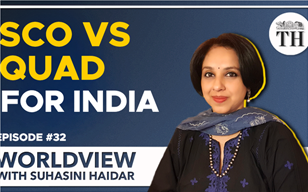This week on WorldView, SCO and Quad summit meetings within a week, can India walk the non-aligned tightrope or is it attempting to put its foot in two boats?
On two Fridays, a week apart, Prime Minister Narendra Modi is attending two very different summits, that some would call geopolitical contradictions of each other. On the one hand, there is the SCO or Shanghai Cooperation Organisation, that is made up of Russia, China, Pakistan, Central Asian countries, India and now Iran…and on the other a visit to Washington to attend the US-Australia-Japan-India Quadrilateral summit.
What are the differences between them:
– SCO led by Russia-China is seen as counter-NATO organisation, while the Quad includes the US and its allies is seen as a coalition to counter China, and by extension Russia.
– India joined the SCO 2017, while the Quad, which had originally begun after the Tsunami in 2004, was shelved in 2009, and was revived in 2017
– SCO deals with India’s Continental neighbourhood, including Afghanistan while the Quad deals with India’s Maritime neighbourhood
– Barring India, SCO countries have largely taken a stand accepting the new Taliban government in Afghanistan, are talking to the Taliban, and want sanctions against them reduced. Quad countries other than the US have stayed more distant from the new regime in Kabul, and have not opened dialogues with the Taliban
– At the SCO, India takes part in meetings, and even military exercises with countries including China and Pakistan, while at the Quad, India has been part of naval exercises and statements decrying regional hegemony and cross-border terrorism aimed at China and Pakistan.
So, you could ask, can India sustain this tightrope, and has the Modi government bitten off more than it can chew? PM Modi also took part in the Brazil Russia India China South Africa BRICS grouping last week, which seems also divided on some issues between the two sides.
1.India is not the only country in multiple multilateral groupings that conflict with each other. Just some examples:
– In the 1950s Pakistan was a part of CENTO – a treaty organisation with the US, while also working closely with China on a number of platforms.
– Turkey is a member of NATO, but also a part of several groupings with Russia and China
– US is a part of the Quad, but has just announced a new trilateral on the Indo-Pacific AUKUS with UK and Australia, that could conflict with the Quad. Two months ago, US also announced a Quad with Uzbekistan, Afghanistan and Pakistan, although it is unclear where that will head.
– And while they compete on every other sphere, US-Russia-China formed the Troika to discuss Afghanistan, with Pakistan a few years ago. While US has maintained the Quad, and Russia and China formed RIC with India, neither have included India in those conversations.
Clearly, in a multipolar world, it is possible to be part of many different groupings, depending on the issue at hand. India has found common cause with both groupings on some issues and has differences on others
What are the main issues under discussion at the Quad?
While ensuring a free and open and prosperous Indo-Pacific region is at the base of the Quad’s revived platform, the leaders: Biden, Suga, Morrison and Modi have focussed on three verticals”
Countering Covid and a Vaccine initiative- India’s proposal at the WTO still blocked, and India has blocked giving indemnity to US vaccines
Climate Change issues- India has worked with Quad countries on the solar alliance, paris accord etc, but has not yet signed on to Net Zero and ending coal deadlines
Critical Technologies and Resilient Supply Chains- While India is keen on building alternate supply chains especially on technologies with partners keen to end dependence on China, it is not part of the Osaka track, that includes other Quad countries, when it comes to cross border data flows
What does the SCO discuss?
– Afghanistan contact group: India is not on the same page as most SCO countries when it comes to dealing with the Taliban- shut down its embassy, and only engaging Taliban to ensure no terrorism spillover
– Connectivity: India is not a part of China’s Belt and Road Initiative, and does not sign on to the paragraph in the joint declaration that deals with the BRI. Tensions between India and Pakistan mean India is not part of any of the connectivity discussions whereas other SCO countries are working on BRI, Trans Afghan railroad, CPEC etc. India’s Chabahar port project has few takers at present.
– Terrorism: India blames Pakistan for cross-border terrorism into India, as well as in providing shelter and safe haven to terror groups that have attacked Afghanistan, including the Taliban itself. However, other countries in the grouping are actively engaging Pakistan in order to deal with the Taliban- and the SCO RATS mechanism, India included, conducts annual counter terror exercises that include Pakistan which is a member.
In short, despite India’s growing ties with the US and growing tensions with China, distance with Russia, the government is for the moment continuing to walk the tightrope, maintaining non alliance or strategic autonomy in each of the spheres it works in. The question remains, with both sides making polarised choices, the fears of another cold war between the US and China-Russia, can it continue to do so.
Book recommendations
At The Hindu website, we have profiles of the SCO, the Quad and BRICS, which you could see.
Non Alignment 2.0: A foreign and strategic policy for India in the 21 century edited by Sunil Khilnani
The India way by S. Jaishankar
India at the Global High Table: Quest for regional primacy and strategic autonomy by Teresita and Howard Schaffer
Indian diplomacy: Beyond Strategic Autonomy by Rajendra Abhyankar
Power and Diplomacy: India’s foreign policies during the cold war, and Power Shift: India and China in a multipolar world by Zorawar Daulet Singh
Source: Read Full Article

